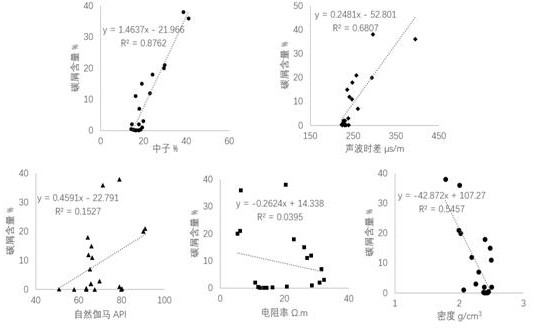Method for calculating porosity of carbon-scrap-containing clastic rock reservoir through geophysical logging
A geophysical and porosity technology, used in geophysical measurement, measurement device, suspension and porous material analysis, etc. problem, to achieve good application effect, improve the accuracy of reservoir physical property evaluation, and achieve the effect of good consistency
- Summary
- Abstract
- Description
- Claims
- Application Information
AI Technical Summary
Problems solved by technology
Method used
Image
Examples
Embodiment
[0039] A method for calculating porosity by geophysical logging of carbon-bearing clastic rock reservoirs, the method comprising:
[0040] Step 1. Determine the carbon debris content of the reservoir: use cuttings or drilling coring to determine the carbon debris content of the clastic rock reservoir.
[0041] Step 2. Determine the logging response characteristics of the carbon debris reservoir: use the carbon debris content calibration logging data determined in step 1 to analyze the logging response characteristics of the carbon debris reservoir. The well logging response features include natural gamma ray, resistivity, neutron, sonic time difference and density features.
[0042] Step 3. Build a model to calculate porosity:
[0043] 1) Establish a cross-plot between the carbon cuttings content and the numerical values of each logging curve, analyze the correlation and quantitative relationship between the carbon cuttings content and each logging curve, and determine the ...
PUM
 Login to View More
Login to View More Abstract
Description
Claims
Application Information
 Login to View More
Login to View More - R&D Engineer
- R&D Manager
- IP Professional
- Industry Leading Data Capabilities
- Powerful AI technology
- Patent DNA Extraction
Browse by: Latest US Patents, China's latest patents, Technical Efficacy Thesaurus, Application Domain, Technology Topic, Popular Technical Reports.
© 2024 PatSnap. All rights reserved.Legal|Privacy policy|Modern Slavery Act Transparency Statement|Sitemap|About US| Contact US: help@patsnap.com










